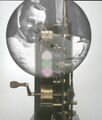Template:Selected anniversaries/April 14: Difference between revisions
No edit summary |
No edit summary |
||
| Line 1: | Line 1: | ||
<gallery> | <gallery> | ||
File:Statue of Ibn Rushd in Cordoba.jpg|link=Ibn Rushd (nonfiction)|1126: Polymath [[Ibn Rushd (nonfiction)|Ibn Rushd]] (Averoess) born. He will write on logic, Aristotelian and Islamic philosophy, theology, the Maliki school of Islamic jurisprudence, psychology, political and Andalusian classical music theory, geography, mathematics, and the mediæval sciences of medicine, astronomy, physics, and celestial mechanics. | File:Statue of Ibn Rushd in Cordoba.jpg|link=Ibn Rushd (nonfiction)|1126: Polymath [[Ibn Rushd (nonfiction)|Ibn Rushd]] (Averoess) born. He will write on logic, Aristotelian and Islamic philosophy, theology, the Maliki school of Islamic jurisprudence, psychology, political and Andalusian classical music theory, geography, mathematics, and the mediæval sciences of medicine, astronomy, physics, and celestial mechanics. | ||
||1527 – Abraham Ortelius, Flemish cartographer and geographer (d. 1598) | |||
||1561 – A Celestial phenomenon is reported over Nuremberg, described as an aerial battle. | |||
||1572 – Adam Tanner, Austrian mathematician, philosopher, and academic (d. 1632) | |||
File:Christiaan Huygens.jpg|link=Christiaan Huygens (nonfiction)|1629: Mathematician, astronomer, and physicist [[Christiaan Huygens (nonfiction)|Christiaan Huygens]] born. He will be a leading scientist of his time. | File:Christiaan Huygens.jpg|link=Christiaan Huygens (nonfiction)|1629: Mathematician, astronomer, and physicist [[Christiaan Huygens (nonfiction)|Christiaan Huygens]] born. He will be a leading scientist of his time. | ||
||1678 – Abraham Darby I, English iron master (d. 1717) | |||
||1800 – John Appold, English engineer (d. 1865) | |||
||1828 – Noah Webster copyrights the first edition of his dictionary. | |||
||1882 – Moritz Schlick, German-Austrian physicist and philosopher (d. 1936) | |||
File:Kinetoscope.jpg|link=Kinetoscope (nonfiction)|1894: The first ever commercial motion picture house opened in New York City using ten [[Kinetoscope (nonfiction)|Kinetoscopes]], a device for peep-show viewing of films. | |||
||1900 – The Exposition Universelle begins. | |||
||1908 – Hauser Dam, a steel dam on the Missouri River in Montana, U.S., fails, sending a surge of water 25 to 30 feet (7.6 to 9.1 m) high downstream. | |||
||1909 – A massacre is organized by the Ottoman Empire against the Armenian population of Cilicia. | |||
||1912 – The British passenger liner RMS Titanic hits an iceberg in the North Atlantic at 23:40 (sinks morning of April 15th). | |||
||1927 – Alan MacDiarmid, New Zealand chemist and academic, Nobel Prize laureate (d. 2007) | |||
||1928 – The Bremen, a German Junkers W 33 type aircraft, reaches Greenly Island, Canada - the first successful transatlantic aeroplane flight from east to west. | |||
File:John_Brunner's_Lee_and_Turner_engine.jpg|link=John Brunner|1934: [[John Brunner]] uses [[Scrying engine|Lee and Turner scrying engine]] to detect and expose [[crimes against mathematical constants]]. | File:John_Brunner's_Lee_and_Turner_engine.jpg|link=John Brunner|1934: [[John Brunner]] uses [[Scrying engine|Lee and Turner scrying engine]] to detect and expose [[crimes against mathematical constants]]. | ||
File:Emmy Noether.jpg|link=Emmy Noether (nonfiction)|1935: Mathematician [[Emmy Noether (nonfiction)|Emmy Noether]] dies. She made landmark contributions to abstract algebra and theoretical physics. | File:Emmy Noether.jpg|link=Emmy Noether (nonfiction)|1935: Mathematician [[Emmy Noether (nonfiction)|Emmy Noether]] dies. She made landmark contributions to abstract algebra and theoretical physics. | ||
||1935 – The Black Sunday dust storm, considered one of the worst storms of the Dust Bowl, swept across the Oklahoma and Texas panhandles and neighboring areas. | |||
File:Lev Schnirelmann.jpg|link=Lev Schnirelmann (nonfiction)|1936: Mathematician [[Lev Schnirelmann (nonfiction)|Lev Schnirelmann]] uses the theorem of the three geodesics to detect and prevent [[crimes against mathematical constants]]. | File:Lev Schnirelmann.jpg|link=Lev Schnirelmann (nonfiction)|1936: Mathematician [[Lev Schnirelmann (nonfiction)|Lev Schnirelmann]] uses the theorem of the three geodesics to detect and prevent [[crimes against mathematical constants]]. | ||
||1939 – The Grapes of Wrath, by American author John Steinbeck is first published by the Viking Press. | |||
||1958 – The Soviet satellite Sputnik 2 falls from orbit after a mission duration of 162 days. This was the first spacecraft to carry a living animal, a female dog named Laika, who likely lived only a few hours. | |||
||1964 – Tatyana Afanasyeva, Russian-Dutch mathematician and theorist (b. 1876) | |||
||1964 – Rachel Carson, American biologist and author (b. 1907) | |||
||1981 – STS-1: The first operational Space Shuttle, Columbia completes its first test flight. | |||
||2000 – Phil Katz, American computer programmer, co-created the zip file format (b. 1962) | |||
||2003 – The Human Genome Project is completed with 99% of the human genome sequenced to an accuracy of 99.99%. | |||
File:Cantor Parabola.jpg|link=Cantor Parabola|2017: Math photographer [[Cantor Parabola]] attends Minicon 52, taking a series of photographs with temporal superimpositions from Minicons 51 and 53. | File:Cantor Parabola.jpg|link=Cantor Parabola|2017: Math photographer [[Cantor Parabola]] attends Minicon 52, taking a series of photographs with temporal superimpositions from Minicons 51 and 53. | ||
</gallery> | </gallery> | ||
Revision as of 21:19, 1 October 2017
1126: Polymath Ibn Rushd (Averoess) born. He will write on logic, Aristotelian and Islamic philosophy, theology, the Maliki school of Islamic jurisprudence, psychology, political and Andalusian classical music theory, geography, mathematics, and the mediæval sciences of medicine, astronomy, physics, and celestial mechanics.
1629: Mathematician, astronomer, and physicist Christiaan Huygens born. He will be a leading scientist of his time.
1894: The first ever commercial motion picture house opened in New York City using ten Kinetoscopes, a device for peep-show viewing of films.
1934: John Brunner uses Lee and Turner scrying engine to detect and expose crimes against mathematical constants.
1935: Mathematician Emmy Noether dies. She made landmark contributions to abstract algebra and theoretical physics.
1936: Mathematician Lev Schnirelmann uses the theorem of the three geodesics to detect and prevent crimes against mathematical constants.
2017: Math photographer Cantor Parabola attends Minicon 52, taking a series of photographs with temporal superimpositions from Minicons 51 and 53.






